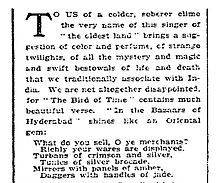| In The Bazaars of Hyderabad | |
|---|---|
| by Sarojini Naidu | |
 The first paragraph of the poem was published in The New York Times on 27 April 1913. The reviewer credited the poem as an "Oriental gem". | |
| Country | India |
| Language | English |
| Subject(s) | Romanticism Lyric poetry |
| Genre(s) | Rhetorical |
| Meter | Trochee |
| Rhyme scheme | ABCBCB |
| Publisher | Heinemann, London John Lane, New York |
| Publication date | c. 1912 |
| Media type | Book |
| Lines | 30 |
"In The Bazaars of Hyderabad" is a poem by Indian Romanticism and Lyric poet Sarojini Naidu (1879–1949). The work was composed and published in her anthology The Bird of Time (1912)—which included "Bangle-sellers" and "The Bird of Time", it is Naidu's second publication and most strongly nationalist book of poems, published from both London and New York City. While studying in England from 1895 to 1898 Naidu ameliorate her poetic expertise under the guidance of her teachers Sir Edmund William Gosse and Arthur Symons. Post Swadeshi Movement (1905) her work began to focus on Indian life and culture. Although actively involved in the Indian independence movement which left her little time to devote to poetry, she composed "In The Bazaars of Hyderabad" from her childhood reminiscence.
The poem is written in five stanzas, Naidu uses imagery and alliteration, with traditional end rhymes, as well as the poem manifests distinct characteristic of Hyderabad's social etiquette, mannerism, lifestyle of aristocracy and the society. In the poem, the Bazaars are just not only meant for buying and selling, but it is also a focal-point for people from different backgrounds having multifarious interests. In this poem, Naidu describes the beauty of traditional Hyderabadi bazaars. She presented the lively picturesque scenes of merchants, vendors, peddlers, goldsmiths, fruit men, and flower girls selling their goods, all of whom answer the questions of purchasers who buy their articles after meticulous chaffering. The poem also describes the musical instruments being used by the musicians and magicians in the bazaar.
The poem is included in academics of Indian education boards and some universities in Europe taught the poem in the English literature syllabus.